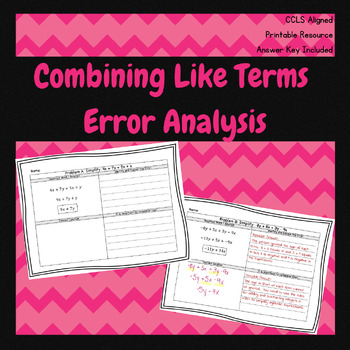- PDF
Description
The activity includes 5 different algebraic equations that have been solved incorrectly.In each problem a common mistake that students often make is revealed.
--------------------------------------------------------------------------------------------------------------------------
Students are expected to …
✔️correctly solve the algebraic equation
✔️ explain in complete sentences where the original solution went wrong
✔️ identify the rule or trick to remember to avoid making the same mistake in the future
--------------------------------------------------------------------------------------------------------------------------
There are several instructional approaches that can be utilized with this set. Some possibilities are…
(1) students solve all 5 problems independently or in groups
(2) students select a set number of problems to solve independently or in groups
(3) students can be asked to present one of the problems
(4) students can each be assigned one problem and then meet in a group to share answers with their group members to eventually have all 5 problems completed
--------------------------------------------------------------------------------------------------------------------------
CCSS Aligned
Primary standard assessed:
CCSS Math.7.EE.A.1: Apply properties of operations as strategies to add, subtract, factor, and expand linear expressions with rational coefficients.
CCSS Math.MP1: Make sense of problems and persevere in solving them.
CCSS Math.MP3: Construct viable arguments and critique the reasoning of others.
Pre-requisite standards:
CCSS Math.6.EE.A.3: Apply the properties of operations to generate equivalent expressions.
CCSS Math 6.EE.A.4: Identify when two expressions are equivalent.
CCSS Math.7.NS.A.1.D: Apply properties of operations as strategies to add and subtract rational numbers.
CCSS Math 7.NS.A.2.C: Apply properties of operations as strategies to multiply and divide rational numbers.
--------------------------------------------------------------------------------------------------------------------------
Answer key is included





